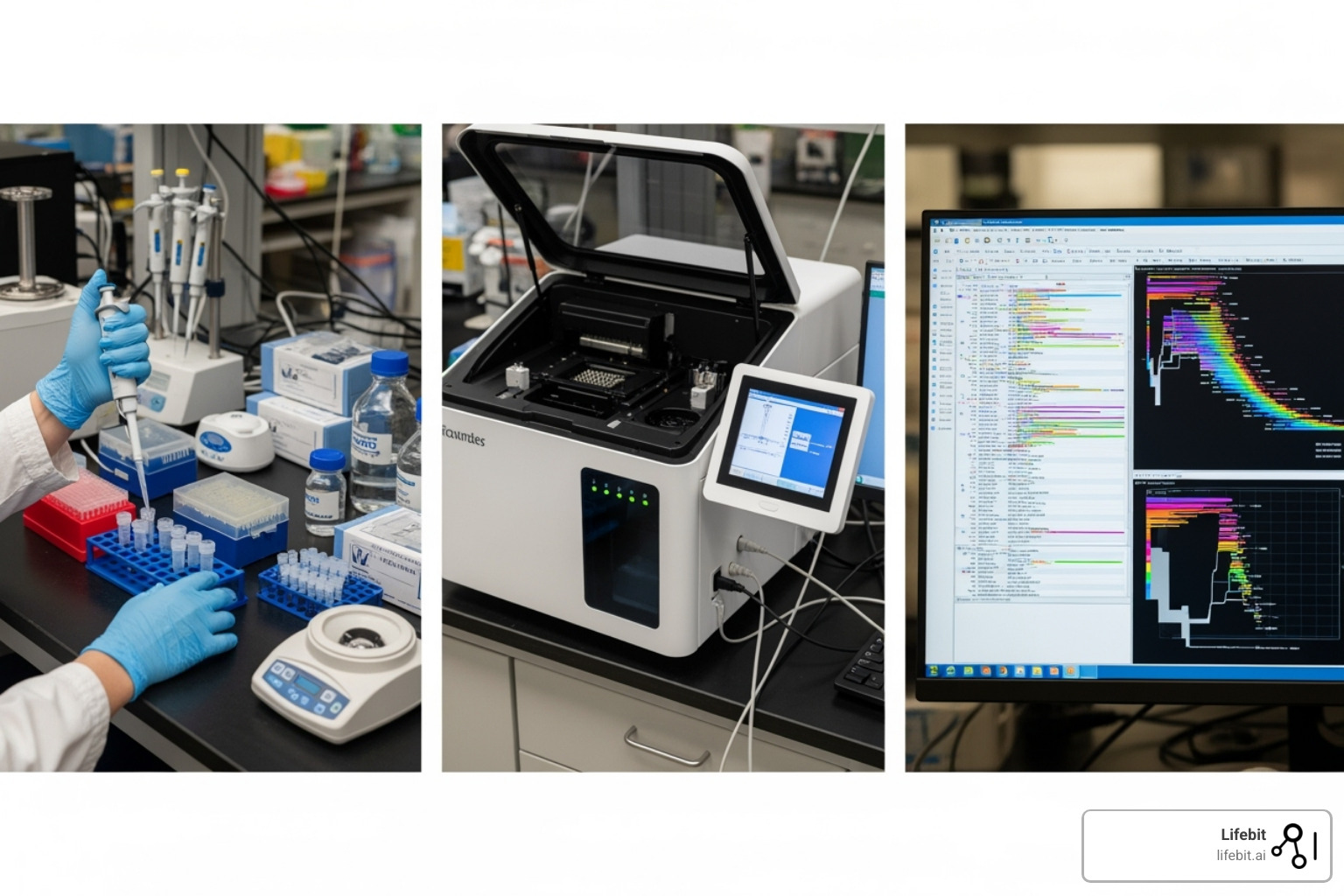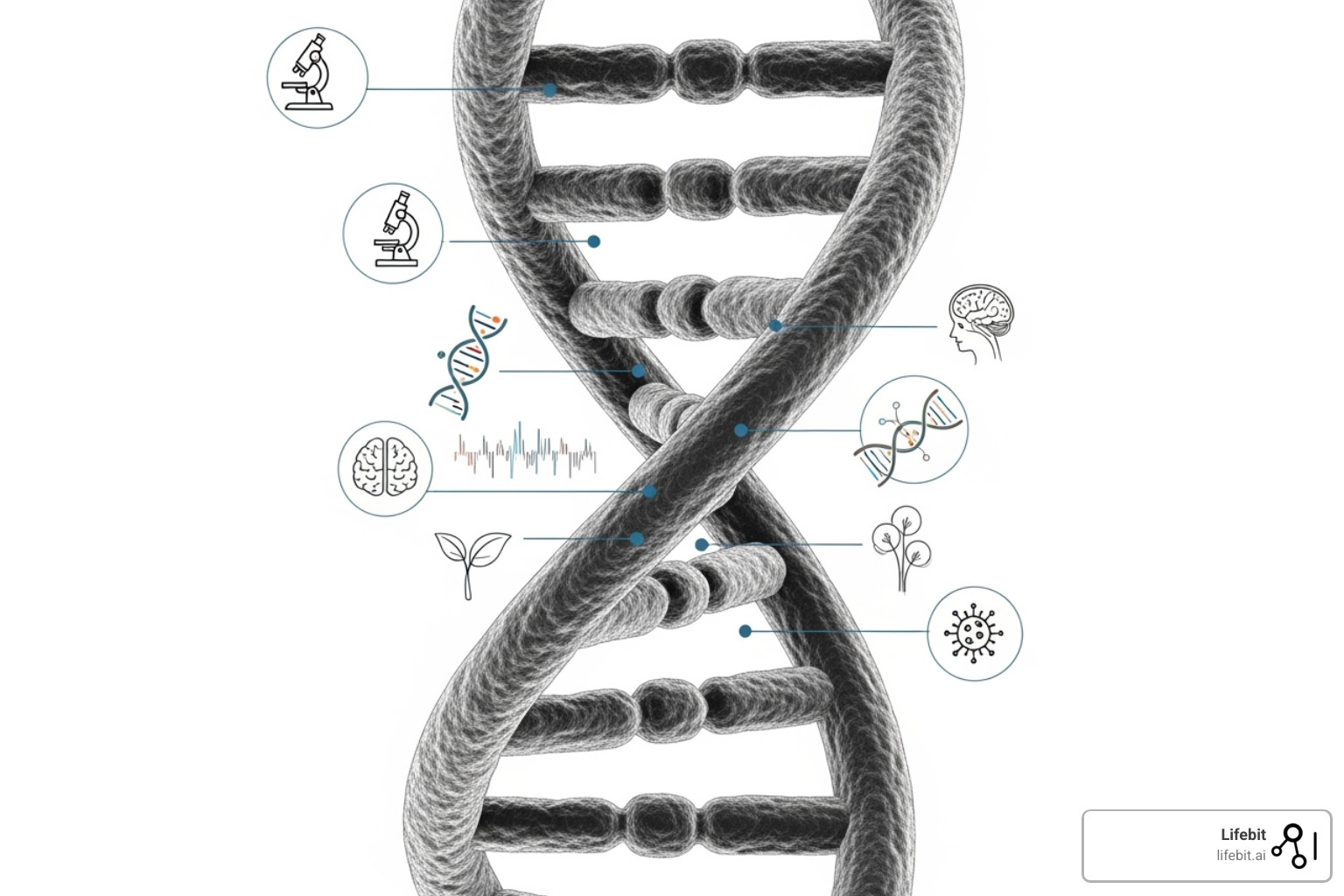Beyond the Microscope: How Next-Generation Sequencers Are Changing Science

Why Next-Generation Sequencers Are Revolutionizing Modern Science
A next generation sequencer is a powerful instrument that simultaneously sequences millions of DNA fragments, dramatically reducing the time and cost of genetic analysis. By sequencing millions to billions of DNA fragments at once, these machines can sequence an entire human genome in 1-2 days. What once took the Human Genome Project over a decade and nearly $3 billion can now be done in a day for around $1,000.
This technological leap has a massive impact beyond basic research, changing clinical diagnostics, enabling rapid pathogen identification, powering precision oncology, and accelerating drug findy. However, these instruments generate unprecedented volumes of information that require sophisticated analysis platforms to open up their full potential.
I’m Maria Chatzou Dunford, CEO and Co-founder of Lifebit. With over 15 years in computational biology and genomics, I’ve contributed to key data analysis tools like Nextflow and now focus on helping organizations harness genomic data through secure, federated platforms.
Basic next generation sequencer glossary:
What is Next-Generation Sequencing (NGS)?
Next-Generation Sequencing (NGS), also known as high-throughput or deep sequencing, is an approach that reads millions of DNA or RNA fragments in parallel. Think of it as thousands of people reading different pages of a book simultaneously and then piecing the story together. This massively parallel process determines the exact order of nucleotides (A, T, C, G) across countless fragments at once.
This capability marks a significant leap from first-generation Sanger sequencing, which could only process one DNA fragment at a time. The Human Genome Project, using Sanger methods, took over 13 years and cost ~$3 billion. Today, a next generation sequencer can accomplish this in a single day for a few thousand dollars. This dramatic improvement in speed, cost, and throughput has made large-scale genomic analysis accessible worldwide. For more detail, see this review of sequencing technologies or our guides on the definition of sequencing and DNA sequencing methods.
Core Advantages of Modern Sequencing
Modern sequencing offers several key advantages:
- Comprehensive Variant Detection: NGS can identify the full spectrum of genetic variations, including single nucleotide variants (SNVs), small insertions and deletions (indels), and large structural variants.
- High Sensitivity: It can detect low-frequency variants, which is critical for finding rare cancer mutations or tracking emerging viral strains.
- Unprecedented Scalability: NGS makes large-scale population studies feasible, allowing researchers to analyze thousands of genomes to understand genetic variation in complex diseases, drug responses, and rare disease mechanisms. This scale is essential for advancing precision medicine and revealing insights into human biology that were previously invisible.
The NGS Workflow: From Sample to Sequence

The next generation sequencer workflow is a meticulously orchestrated process involving three essential stages: Library Preparation, Sequencing, and Data Analysis. The quality of the final data is only as good as the weakest link in this chain. Therefore, success at each step is critical for reliable results, starting with rigorous sample quality control and often leveraging automation in library prep to ensure consistency and minimise human error across large cohorts.
Step 1: Library Preparation
This crucial first stage converts a biological sample (like blood, tissue, or saliva) into a format the sequencer can read, known as a ‘library’. It begins with a thorough assessment of sample input requirements. High-quality input is paramount; for RNA, this is often measured by the RIN (RNA Integrity Number), while for DNA from challenging clinical FFPE samples (formalin-fixed, paraffin-embedded), the DV200 metric (percentage of fragments over 200 nucleotides) is a key predictor of success. Poor quality samples can lead to sequencing failures or biased, uninterpretable data.
Key steps in library preparation include:
- Fragmentation: Long native DNA or RNA molecules are too large for most sequencers. They are broken into smaller, more uniform pieces, typically in the 200-500 base pair range for short-read sequencing. This can be done physically (e.g., acoustic shearing/sonication) for random fragmentation or enzymatically for a faster, gentler process that can sometimes introduce sequence-specific biases.
- Adapter Ligation: Short, synthetic DNA sequences called adapters are attached to both ends of the DNA fragments. These adapters are multifunctional: they contain sequences that allow the fragments to bind to the sequencer’s flow cell, provide a binding site for sequencing primers, and include unique DNA barcodes (or indexes) for multiplexing.
- Multiplexing and Barcoding: By adding a unique barcode to every fragment from a given sample, researchers can pool multiple samples together and sequence them in a single run. The barcodes act as ‘address labels’, allowing the data from each sample to be separated bioinformatically after the run. This dramatically increases throughput and reduces the cost per sample.
- Target Enrichment: For many applications, sequencing the entire genome is unnecessary and cost-prohibitive. Instead, researchers can focus on specific genes or regions of interest. Hybrid capture uses biotinylated RNA or DNA probes to ‘fish out’ and enrich for desired genomic regions, making it ideal for whole-exome sequencing. Amplicon sequencing uses PCR to amplify a few specific targets, a fast and cost-effective approach for small gene panels.
Step 2: Sequencing on a Next Generation Sequencer
The prepared library is loaded onto a flow cell, a glass slide with a lawn of immobilised oligonucleotides that are complementary to the library adapters. The library fragments bind to the flow cell, and each fragment is then amplified into a dense, clonal cluster through a process called Bridge PCR. This creates millions of distinct clusters, each containing thousands of identical copies of a single original fragment.
Most modern short-read platforms use Sequencing by Synthesis (SBS) chemistry. In this method, fluorescently labeled nucleotides with reversible terminators are washed over the flow cell one by one. At each cycle, a DNA polymerase incorporates the complementary nucleotide into the growing strand. The terminator prevents further additions, an optical detection system excites the fluorophore and records its colour, and the image data is stored. The fluorophore and terminator are then chemically cleaved, and the cycle repeats. This process, performed in parallel across millions of clusters, generates highly accurate sequence reads.
Other technologies are also prominent. Real-time single-molecule sequencing platforms, like those from PacBio, observe a single DNA polymerase molecule at work in real-time, generating very long reads. Nanopore sequencing from Oxford Nanopore Technologies takes a different approach, passing a native DNA or RNA strand through a protein pore and measuring the characteristic disruption in an electrical current as each base passes through. This enables direct, real-time sequencing of DNA or RNA without amplification and can even detect epigenetic modifications.
Step 3: Data Analysis and Interpretation
This computational stage transforms the billions of short sequence reads from the instrument into meaningful biological insights.
- Primary Analysis: This occurs on the sequencer itself. The machine’s software performs base calling, converting the raw image signals from each cycle into DNA sequences (A, T, C, G) and assigning a quality score (e.g., Q30, which indicates a 99.9% base call accuracy) to each base. This data is stored in a standard FASTQ file format.
- Secondary Analysis: The raw reads in the FASTQ files are processed through a bioinformatics pipeline. First, they are aligned or mapped to a reference genome. Then, sophisticated algorithms perform variant calling to identify where the sequenced sample differs from the reference. The aligned reads are stored in BAM files, and the identified genetic differences are stored in VCF (Variant Call Format) files.
- Tertiary Analysis: This final, interpretive step involves annotation and filtering. The variants in the VCF file are compared against public and private databases to determine their frequency in the population, their predicted effect on protein function, and their potential clinical significance. This process is crucial for turning raw data into actionable insights, as detailed in our guide on clinical data interpretation.
A Guide to Next Generation Sequencer Technologies
Choosing the right next generation sequencer technology is a critical decision that depends entirely on the research question, available budget, and desired turnaround time. It’s much like picking a camera: a high-speed camera is perfect for capturing fast motion, while a high-resolution landscape camera is needed for fine detail. The main choice in genomics is between short-read and long-read platforms, each with a unique combination of strengths and weaknesses in read length, accuracy, throughput, and error profile.
| Feature | Short-Read Sequencing | Long-Read Sequencing |
|---|---|---|
| Read Length | 50-300 base pairs (bp) | Kilobases (kb) to Megabases (Mb) |
| Accuracy | Very high (Q30+ for consensus, ~99.9%) | Lower single-read (~87-99%), very high consensus (>99.999%) |
| Throughput | Extremely high (terabases per run) | High (hundreds of gigabases per run) |
| Run Time | Hours to a few days | Hours to a few days |
| Error Profile | Substitutions, low indel errors, GC bias in coverage | Higher random indel errors, minimal GC bias |
| Applications | SNV/indel calling, WES, RNA-Seq, gene expression | Structural variants, de novo assembly, epigenetics |
Short-Read Sequencing Platforms
Short-read platforms, dominated by Illumina (with instruments like the NovaSeq, NextSeq, and MiSeq), are the undisputed workhorses of modern genomics. They are renowned for their reliability, unparalleled throughput, and extremely low cost per base. Using Sequencing by Synthesis (SBS) chemistry, they generate massive volumes of highly accurate (over 99.9% consensus accuracy) reads of 50-300 bp. This high fidelity makes them the gold standard for applications requiring confident detection of small-scale genetic changes. Their primary applications include:
- Detecting single nucleotide variants (SNVs) and small insertions and deletions (indels).
- Whole-exome sequencing (WES) and targeted gene panels for clinical diagnostics.
- RNA-Seq for quantifying gene expression and differential expression analysis.
However, their short read length is a significant limitation. It makes assembling a genome from scratch (de novo assembly) extremely difficult, like trying to solve a massive jigsaw puzzle with tiny, confetti-like pieces. Short reads also struggle to map to repetitive regions of the genome and cannot reliably detect large structural variants like inversions or translocations.
Long-Read and Single-Molecule Sequencing
Long-read technologies, led by Pacific Biosciences (PacBio) and Oxford Nanopore Technologies (ONT), excel precisely where short reads fail. By generating reads that span thousands to even millions of bases, they can easily traverse repetitive regions and complex genomic rearrangements. This makes them essential for:
- High-quality de novo genome assembly.
- Comprehensive structural variant detection.
- Phasing haplotypes (determining which variants are on the same chromosome).
While the accuracy of a single long-read molecule has historically been lower than short reads, this has changed dramatically. PacBio’s HiFi reads, which are generated by circularizing a DNA molecule and sequencing it multiple times, now achieve >99.9% accuracy, rivalling short reads but with much greater length. Similarly, advances in ONT’s chemistry and base-calling algorithms are continuously improving accuracy. Furthermore, these platforms can directly sequence native DNA or RNA, enabling the detection of epigenetic modifications (like methylation) without special library preparation. The main trade-off is a higher cost per base compared to short-read sequencing, though this gap is rapidly closing.
Often, a hybrid approach that combines both technologies provides the most complete and accurate picture of a genome. Long reads are used to create a high-quality, contiguous assembly (the ‘scaffold’), and then highly accurate short reads are used to ‘polish’ this scaffold, correcting any minor errors. This strategy leverages the strengths of both platforms to produce reference-quality genomes.
Key Applications of NGS

The true power of a next generation sequencer is evident in its vast and diverse applications, which are fundamentally transforming biological research and clinical medicine. NGS has democratized genomics, enabling labs of all sizes to tackle ambitious projects and accelerate the move towards multi-omics research, where different layers of biological information are integrated to create a holistic view of health and disease.
Genomics and Transcriptomics
These applications focus on decoding our genetic blueprint (DNA) and understanding its functional output (RNA).
- Whole Genome Sequencing (WGS) offers the most comprehensive view of the genome, capturing everything from single nucleotide changes to large-scale structural rearrangements. It is the method of choice for large population genetics studies and is increasingly used in clinical settings for diagnosing rare diseases, where causative mutations may lie in non-coding regions missed by other methods.
- Whole Exome Sequencing (WES) provides a cost-effective alternative by focusing only on the protein-coding regions (the exome), which constitute about 1-2% of the genome but harbour approximately 85% of known disease-causing mutations. This makes it a powerful and efficient tool for identifying the genetic basis of Mendelian disorders.
- Targeted gene panels offer a highly focused approach, delivering deep coverage of a pre-selected set of genes known to be associated with a particular disease, such as cancer or cardiomyopathy. This depth allows for highly sensitive detection of rare variants.
- RNA-Seq has largely replaced older microarray technologies for studying the transcriptome. It not only measures gene expression levels with high accuracy and a wide dynamic range but can also identify novel transcripts, detect alternative splicing events, and discover gene fusions.
- Single-cell and spatial transcriptomics are revolutionising our understanding of complex tissues. Single-cell RNA-seq allows researchers to dissect cellular heterogeneity, for instance, by identifying rare cancer stem cells within a tumour. Spatial transcriptomics goes a step further by placing this information back into its morphological context, creating a detailed map of how different cell types are organised and interact within a tissue.
Clinical and Translational Applications
NGS has moved rapidly from the research lab into the clinic, with a profound impact on patient care.
- Precision oncology: Sequencing a patient’s tumour to identify specific ‘driver mutations’ is now standard practice in many cancer types. For example, finding an EGFR mutation in a lung cancer patient can guide treatment with a targeted inhibitor, often leading to far better outcomes than traditional chemotherapy. Furthermore, sequencing circulating tumour DNA (ctDNA) from a blood sample—a ‘liquid biopsy’—allows for non-invasive monitoring of treatment response and early detection of relapse.
- Rare disease diagnosis: For patients and families on a long ‘diagnostic odyssey’, WGS and WES can provide a definitive genetic diagnosis, ending years of uncertainty and enabling appropriate management, genetic counselling, and connection to support communities.
- Infectious disease surveillance: NGS was a cornerstone of the global response to the COVID-19 pandemic. It enabled the rapid sequencing of the SARS-CoV-2 virus, which was critical for developing diagnostics and vaccines. It continues to be used for genomic surveillance to track the emergence and spread of new variants, informing public health strategies in real-time.
- Non-invasive prenatal testing (NIPT): This screening method analyzes cell-free fetal DNA circulating in the mother’s blood to test for common chromosomal abnormalities like trisomy 21 (Down syndrome) with high accuracy, reducing the need for more invasive procedures.
- Pharmacogenomics: This field aims to tailor drug prescriptions based on an individual’s genetic profile. By identifying genetic variants that affect drug metabolism, efficacy, or risk of adverse events, clinicians can select the right drug at the right dose for each patient, a key pillar of future precision medicine.
Epigenomics and Metagenomics
NGS also provides powerful tools to explore layers of regulation beyond the DNA sequence itself.
- ChIP-Seq (Chromatin Immunoprecipitation Sequencing) maps the locations where specific proteins (like transcription factors) bind to DNA across the genome, helping to unravel gene regulatory networks.
- Methylation sequencing (e.g., Whole Genome Bisulfite Sequencing) detects chemical modifications to DNA (methylation) that can turn genes on or off without changing the underlying sequence. These epigenetic patterns are crucial in development and are often dysregulated in cancer.
- Microbiome analysis, using 16S rRNA sequencing or shotgun metagenomics, characterizes the vast communities of microbes living in and on our bodies, linking them to health and diseases ranging from inflammatory bowel disease to mental health.
- Environmental DNA (eDNA) analysis uses NGS to detect trace amounts of DNA from organisms in environmental samples like water or soil, revolutionizing biodiversity monitoring and conservation efforts.
From Raw Data to Actionable Insights: The Bioinformatics Challenge

Next generation sequencers produce a “data deluge”—a single high-throughput instrument can generate multiple terabytes of information in just a few days. This creates significant logistical and analytical problems related to data storage, computation, and, most importantly, data security and governance. Turning this mountain of raw data into clinically actionable insights requires a sophisticated, scalable, and secure computational infrastructure that many research and healthcare organizations find challenging to build and maintain, as we’ve explored in these big data challenges in genomics.
Building a Reproducible Bioinformatics Pipeline
A bioinformatics pipeline is a series of computational steps, chained together in an automated workflow, to process raw sequencing data. A typical pipeline includes:
- Quality Control: Raw sequence reads are checked for quality using tools like FastQC. Aggregators like MultiQC then compile these reports, allowing researchers to quickly assess the quality of an entire batch of samples and spot potential issues like adapter contamination or failed sequencing runs.
- Alignment: The high-quality reads are mapped to a reference genome (e.g., the latest human reference, GRCh38) using aligners like BWA or STAR. This step determines the genomic origin of each read.
- Variant Calling: After alignment, algorithms like the GATK‘s HaplotypeCaller or DeepVariant scan the data to identify positions where the sequenced sample differs from the reference genome. This process generates a list of genetic variants (SNVs, indels, etc.).
- Annotation: The identified variants are annotated with information from various databases (e.g., dbSNP, ClinVar). This step provides biological context, such as the variant’s frequency in the population and its known or predicted clinical significance, helping to distinguish benign polymorphisms from potentially pathogenic mutations.
Using standardized bioinformatics pipelines, often packaged in containers like Docker or Singularity, is crucial for ensuring that analyses are reproducible, transparent, and reliable across different studies and institutions.
The Challenge of Secure and Scalable Data Management
Genomic data is not just big; it is also one of the most sensitive forms of personal information. Managing massive datasets containing various data formats (FASTQ, BAM, VCF) while complying with strict data privacy regulations like HIPAA and GDPR creates a fundamental tension. Researchers need to access and combine diverse datasets to achieve statistical power, but legal and ethical mandates require that this sensitive patient data remain secure and private.
Modern solutions are emerging to resolve this dilemma:
- Trusted Research Environments (TREs): Also known as secure data enclaves, TREs are highly controlled computing environments where approved researchers can analyze sensitive data without being able to move or download it. The data remains within a secure perimeter, and all analyses are conducted using a provided set of tools, with strict auditing of all actions. Learn more about TREs.
- Federated Data Analysis: This groundbreaking approach flips the traditional data sharing model on its head. Instead of bringing data to a central location for analysis, it brings the analysis to the data. An analysis workflow is sent to run locally within each data holder’s secure environment (e.g., a hospital’s TRE). Only the aggregated, non-identifiable results are returned and combined, allowing insights to be generated from distributed datasets without ever moving or exposing the sensitive raw information. We have pioneered federated data analysis to make this a global reality.
- Cloud Computing: The cloud provides the on-demand, scalable compute and storage resources necessary to handle the massive data volumes from NGS. It eliminates the need for organizations to purchase and maintain costly on-premise high-performance computing clusters and facilitates data harmonisation and collaboration.
- AI and Machine Learning: As datasets grow into the millions of genomes, AI for genomics is becoming essential. Machine learning models can identify complex patterns in massive datasets that are invisible to human analysis, improving everything from variant calling accuracy to predicting disease risk from genomic and clinical data.
Frequently Asked Questions about Next Generation Sequencers
Here are answers to common questions about working with next generation sequencer data.
How do researchers decide on sequencing depth or coverage?
Sequencing depth, or coverage, is the average number of times each base is sequenced. The required depth depends on the application and the type of variant being studied, balancing statistical power against cost.
- WGS for germline variants: 30x coverage is a common standard.
- WES: Typically requires higher coverage, around 100x.
- Cancer panels or rare variant detection: May need 500x to 1000x coverage or more to confidently detect low-frequency mutations.
- Variant Type: Detecting SNVs requires less coverage than detecting copy number variations (CNVs).
When does it make sense to outsource sequencing versus building in-house capacity?
This decision depends on several factors:
- Project Volume: Outsourcing is cost-effective for low-volume projects, while high, consistent volumes may justify in-house capacity.
- Total Cost of Ownership (TCO): In-house sequencing involves significant costs beyond the instrument, including consumables, staff, and data infrastructure. Outsourcing offers a predictable per-sample cost.
- Staff Expertise: Running an NGS facility requires specialized wet-lab and bioinformatics skills. Outsourcing provides immediate access to this expertise.
- Turnaround Time: In-house provides more control, but many service providers offer competitive turnaround times.
Many organizations use a hybrid model, outsourcing routine work and keeping specialized projects in-house.
What are the key ethical considerations for NGS?
The power of next generation sequencer technology comes with significant ethical responsibilities.
- Informed Consent: Participants must fully understand how their genetic data will be used, stored, and shared.
- Incidental Findings: Clear policies are needed for handling unexpected, clinically significant findings unrelated to the primary research question.
- Data Sharing and Patient Privacy: Frameworks must balance the need for data sharing to advance science with the imperative to protect patient privacy. This is a core focus of our work on genomic data privacy.
- Return of Results: Policies must define which results are clinically actionable and should be returned to patients.
- Genetic Discrimination: Protecting individuals from misuse of their genetic information by employers or insurers remains a critical concern.
Conclusion
The next generation sequencer has fundamentally reshaped modern science, making it possible to sequence a human genome in a day for a few thousand dollars. This democratization of genomics has become the backbone of biological research, powering advances in precision medicine, rare disease diagnosis, and infectious disease surveillance.
However, generating this data has created a new challenge: the data deluge. Making sense of the terabytes of information from each sequencing run requires sophisticated, secure, and scalable analytics infrastructure.
This is where Lifebit’s role is crucial. Our platform enables secure, federated analysis of global biomedical data, allowing researchers to collaborate and gain insights while sensitive data remains protected in its local environment. We provide the tools to address privacy concerns while enabling the large-scale analysis that drives medical breakthroughs.
The future lies in multi-omics integration and AI-driven interpretation to paint a complete picture of health and disease. The next generation sequencer opened the door; platforms like ours provide the secure, scalable infrastructure to turn that data into life-changing insights.
Ready to harness the full potential of your genomic data? Explore Lifebit’s federated data analysis platform and find how we can help you.

